Articles
- Page Path
- HOME > J Korean Powder Metall Inst > Volume 24(5); 2017 > Article
-
ARTICLE
나노-마이크로 크기 하이브리드 구조 텅스텐 분말특성에 미치는 분말혼합 공정의 영향 - 권나연, 정영근a, 오승탁*
- Effect of Powder Mixing Process on the Characteristics of Hybrid Structure Tungsten Powders with Nano-Micro Size
- Na-Yeon Kwon, Young-Keun Jeonga, Sung-Tag Oh*
-
Journal of Korean Powder Metallurgy Institute 2017;24(5):384-388.
DOI: https://doi.org/10.4150/KPMI.2017.24.5.384
Published online: September 30, 2017
서울과학기술대학교 신소재공학과
부산대학교 융합학부
Department of Materials Science and Engineering, Seoul National University of Science and Technology, Seoul 01811, Republic of Korea
a Graduate School of Convergence Science, Pusan National University, Busan 46241, Republic of Korea
- *Corresponding Author: Sung-Tag Oh, +82-2-970-6631, +82-2-973-6657, stoh@seoultech.ac.kr
• Received: August 22, 2017 • Revised: October 11, 2017 • Accepted: October 13, 2017
© The Korean Powder Metallurgy Institute. All rights reserved.
- 743 Views
- 3 Download
- 5 Crossref
Abstract
- The effect of the mixing method on the characteristics of hybrid-structure W powder with nano and micro sizes is investigated. Fine WO3 powders with sizes of ~0.6 μm, prepared by ball milling for 10 h, are mixed with pure W powder with sizes of 12 μm by various mixing process. In the case of simple mixing with ball-milled WO3 and micro sized W powders, WO3 particles are locally present in the form of agglomerates in the surface of large W powders, but in the case of ball milling, a relatively uniform distribution of WO3 particles is exhibited. The microstructural observation reveals that the ball milled WO3 powder, heat-treated at 750°C for 1 h in a hydrogen atmosphere, is fine W particles of ~200 nm or less. The powder mixture prepared by simple mixing and hydrogen reduction exhibits the formation of coarse W particles with agglomeration of the micro sized W powder on the surface. Conversely, in the powder mixture fabricated by ball milling and hydrogen reduction, a uniform distribution of fine W particles forming nano-micro sized hybrid structure is observed.
- 텅스텐(W)은 고융점(3410°C), 고밀도(19.3 g/cm3) 및 낮 은 열팽창계수와 우수한 내아크성 등 고온에서의 열적 특 성이 우수하여 용접봉재, 고부하 전기접점재 및 로켓용 노 즐재료 등에 응용되고 있다[1-3]. W은 주조 등 일반적인 금속가공 공정으로 최종제품을 제조하기에는 높은 융점 때문에 제약이 있어 분말야금 기술을 이용한다. 그러나 난 소결성 재료에서 높은 소결체 밀도를 얻을 수 있는 방법 으로 알려진 열간정수압성형(hot isostatic pressing) 및 방 전소결(spark plasma sintering) 등의 가압소결 방법을 적용 하더라도 완전 치밀체 제조에는 어려움이 있다[4-5].
- W 소결체의 밀도 향상을 위한 방법으로는 활성소결과 나노소결 공정이 제시되었다. W분말에 미량의 천이금속 을 첨가하는 활성소결 공정은 99% 이상의 높은 상대밀도 를 갖는 소결체로의 제조가 가능하나, 천이금속 원소의 입 계 편석에 따른 취성으로 기계적 특성이 저하되는 문제가 있다[6]. 나노소결은 마이크로 크기에 비해 매우 큰 비표 면적을 갖는 나노크기 분말을 이용하는 것으로, 나노분말 의 높은 소결 구동력과 함께 분말 크기가 감소함에 따라 빠른 원자확산 경로인 계면과 입계의 양이 급격하게 증가 하여 물질이동이 촉진되기 때문에 높은 소결성을 나타낸 다[7, 8]. 그러나 나노소결에서는 분말의 합성과 산화제어 등 고비용의 복잡한 공정이 요구되는 단점이 있다.
- 최근에는 나노크기와 마이크로 크기의 분말을 혼합하여 고밀도 소결체를 제조하는 연구가 진행되고 있다. Choi 등 [9]은 마이크로 크기의 Fe 분말과 비교할 때 나노-마이크 로 크기 분말이 혼합된 경우에서 더 높은 소결밀도를 나 타내는 것을 보고한 바 있으며, 이러한 높은 소결성은 주 로 나노분말 들이 마이크로 분말 사이에 위치하여 성형체 밀도가 증가하고 또한 소결과정 중에 나노분말 들이 빠른 목 성장과 입계확산에 기여했기 때문으로 해석하였다. 한 편 W 계에서도 20%의 나노크기 분말을 혼합할 경우 소 결온도의 감소와 함께 상압소결 공정으로 최대 97%의 상 대밀도를 가지는 소결체의 제조가 가능함을 보여주었다 [10]. 따라서 본 연구그룹에서는 볼 밀링한 WO3 분말의 수소환원 거동과 나노-마이크로 크기 혼합분말의 합성에 관한 연구를 진행한 바 있으나[11], 정확한 미세조직 제어 를 위해서는 혼합공정 등의 영향에 관한 체계적인 연구가 요구된다.
- 본 연구에서는 고밀도 W 소결체 제조를 위한 원료분말 로 나노-마이크로 크기가 혼합된 하이브리드 구조 W 분 말을 합성하고자 하였다. 혼합분말은 WO3 분말의 볼 밀 링, 마이크로 크기 W 분말과의 혼합 및 수소환원 공정으 로 제조하였으며, 혼합공정이 분말의 미세조직 특성에 미 치는 영향을 분석하였다.
서 론
- 나노-마이크로 크기의 W 혼합분말에 대한 원료로는 WO3(99.9%, 1 μm, Kojundo Chemical Lab., Co., Japan)와 W(99.9%, 12 μm, Sigma-Aldrich Co., USA) 분말을 사용 하였다. 우선 WO3 분말의 미세화를 위해 수평식 회전형 밀을 이용하여 직경 3 mm의 ZrO2 볼과 함께 ethanol 용액 내에서 밀링하였다. 볼과 분말은 15:1의 무게비로 첨가하 였으며 밀링은 1~20시간 동안 실시하였다. 나노-마이크로 크기 혼합분말의 제조공정이 분말특성에 미치는 영향을 고찰하고자 밀링한 WO3와 W 분말은 각각 3차원 혼합기 를 이용하거나 또는 볼 밀링 공정을 이용하여 10시간동안 혼합하였다. 이때 WO3 분말의 첨가량은 수소환원 후 5 wt%가 혼합되도록 하였다.
- WO3 분말의 환원거동은 TPR(temperature programmed reduction)을 이용하여 Ar-10% H2 혼합가스 분위기에서 800°C까지 가열하며 배출가스의 열전도도(TCD)를 측정하 여 해석하였다[12]. 원료 및 혼합분말의 입자크기는 레이 저입도분석기(Ls I3 320, Beckman Counter Co., USA)를 이용하여 측정하였으며, 분말제조 단계에서의 상변화와 미세조직은 각각 XRD(D/Max-IIIC, Rigaku Denki Co., Japan)와 SEM(JSM-6700F, JEOL Co., Japan)을 이용하여 분석하였다.
실험 방법
- 본 연구에서 사용한 원료분말의 입도분포 분석결과를 그림 1에 나타내었다. WO3 분말은 일부 응집체의 형성에 따라 bimodal 형태의 분포를 보여주며 평균크기는 0.88 μm로 측정되었다. W 분말의 입도는 25.8 μm로 측정 되었으나 실제 SEM으로 관찰한 평균크기는 약 12 μm을 나타내었다. 이러한 차이는 주로 W 분말 응집체가 입도측 정 중에 완전히 분리되지 않아 측정오차가 발생하였기 때 문으로 판단된다.
- 그림 2는 밀링시간에 따른 WO3 분말의 입도분석 결과 로서, 1시간의 밀링에서는 입자크기가 증가하나 그 이후 로는 감소되어 10시간 이후로는 약 0.6 μm로 거의 동일한 크기를 나타낸다. 밀링초기 단계에서의 입자크기 증가는 주로 분말간의 압접에 기인한 것이며, 밀링시간의 증가에 따라 압접된 분말들의 파괴가 발생하여 입자크기가 감소 한 것으로 해석된다[13]. 따라서 본 연구에서는 거의 동일 한 입자크기를 나타내는 조건인 10시간을 밀링조건으로 결정하였다. 그림 3은 10시간 밀링한 분말의 미세조직 사 진으로 그림 2의 입도분석 결과보다는 작은 크기를 나타 내며 일부에서 응집체가 형성되고 있음을 알 수 있다.
- 10시간동안 볼 밀링한 WO3 분말에 W 원료분말을 첨가 한 후 각각 단순혼합 및 볼 밀링 공정으로 제조한 하이브 리드 구조 W 혼합분말의 미세구조 사진을 그림 4에 나타 내었다. 혼합공정에 관계없이 마이크로 크기의 W 분말 표 면에 미세한 WO3 분말들이 분포하나, 그림 4(a)와 같이 단순혼합의 경우에는 국부적으로 많은 양의 WO3 분말들 이 응집체를 형성하며 존재하는 등 볼 밀링한 경우(그림 4b)와 비교하여 상대적으로 불균일한 분포를 나타내었다. 그림 5는 혼합공정에 따른 입도분포를 분석한 결과로서, 상이한 크기를 가지는 분말의 혼합에 따라 전형적인 bimodal 형태의 입도분포를 나타낸다. 또한 WO3 분말크 기는 혼합공정에 커다란 영향을 받지 않으나 W 분말의 경우는 단순혼합 공정과 비교하여 볼 밀링에 따라 입도분 포 곡선이 크기가 감소하는 방향으로 이동함을 알 수 있 으며, 이는 밀링에 따른 응집체 들의 파쇄에 의한 것으로 해석된다.
- 그림 6은 볼 밀링한 WO3 분말의 환원거동을 분석하고 자 TPR을 이용하여 Ar-10% H2 가스의 환원성 분위기에 서 승온속도 5°C/min로 가열하며 반응변화를 측정한 결과 이다. 그림과 같이 약 560°C~720°C의 온도구간에서 2개의 피크가 관찰되며 이는 주로 중간반응상인 WO2.9-2.72 및 WO2의 형성과 환원반응에 기인한 것으로 해석된다[14]. 그림 7은 TPR 결과에서 환원반응이 종료되는 온도 이상 인 750°C에서 1시간동안 열처리한 후 관찰한 분말의 미세 조직 사진이다. 환원된 분말은 일부 응집체를 형성하고 있 으나 200 nm이하의 미세한 입자로 존재함을 알 수 있다.
- 수소분위기에서 열처리한 WO3-W 혼합분말의 환원여부 를 확인하기 위해 XRD 분석을 실시하였다. 그림 8(a)와 (b)는 각각 볼 밀링한 혼합분말과 환원처리 후의 XRD 결 과를 나타낸 것으로 혼합분말의 경우에는 WO3와 W상에 해당하는 피크가 관찰된다. 그러나 750°C에서 1시간동안 수소분위기에서 열처리한 경우에는 다른 반응상의 형성 없이 순수한 W상에 대한 피크만 존재하며, 이러한 경향은 단순 혼합한 분말에서도 동일한 결과를 나타내었다. 따라 서 본 실험에서 사용한 열처리 조건으로 혼합분말의 완전 한 환원이 가능함을 보여준다.
- 그림 9는 상이한 혼합공정을 적용하여 제조한 분말을 수소분위기에서 열처리한 후 관찰한 미세조직 사진이다. 그림 9(a)와 같이 단순혼합 공정으로 제조한 분말에서는 마이크로 크기의 W 분말표면에 조대한 W 입자 및 응집 체 등이 관찰된다. 그러나 볼 밀링한 혼합분말에서는 그림 9(b)와 같이 상대적으로 미세한 W 입자들이 균일하게 분 포하고 있음을 알 수 있다. 따라서 볼 밀링에 의한 혼합과 수소분위기에서의 열처리 공정으로 나노-마이크로의 하이 브리드 구조를 갖는 W 분말의 제조가 가능하며, 향후 하 이브리드 구조 분말이 소결성에 미치는 영향에 대한 연구 가 요구된다.
실험결과 및 고찰
Fig. 4
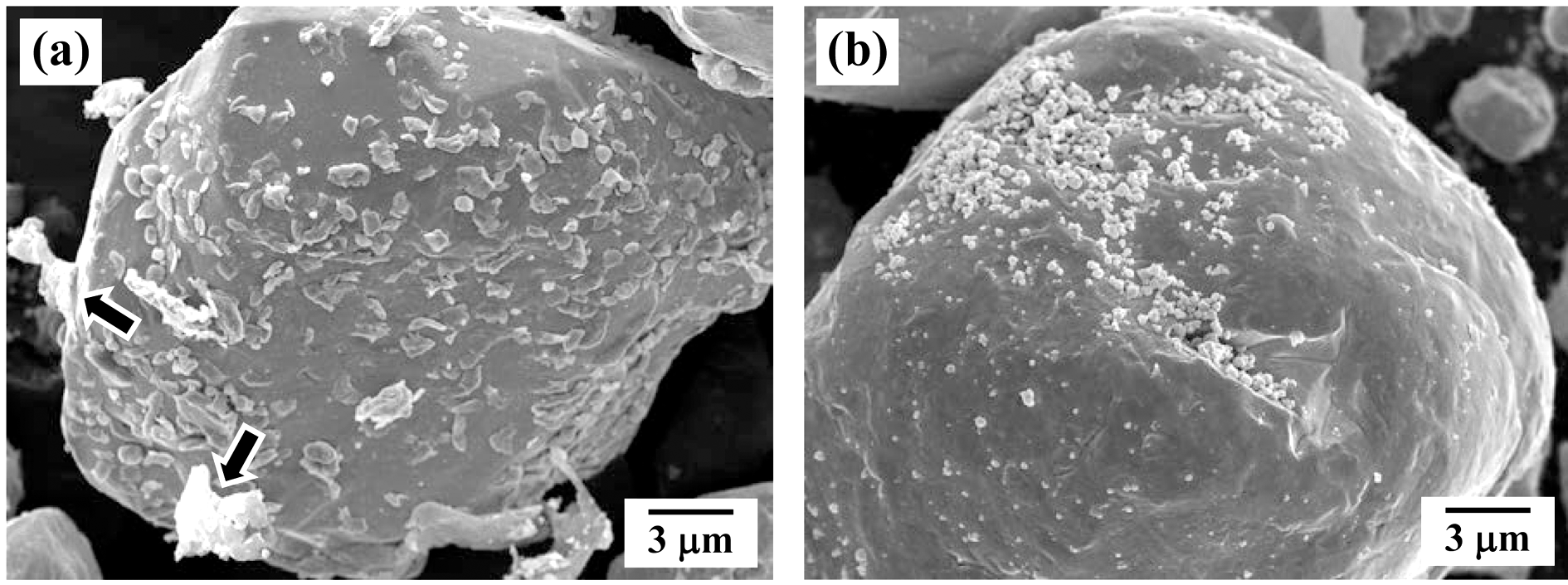
SEM image from powder mixture of WO3 and W, prepared by (a) simple mixing and (b) ball milling. Some WO3 agglomerates are marked.

Fig. 5

Particle size distribution for the powder mixture of WO3 and W, prepared by (a) simple mixing and (b) ball milling.

- 나노-마이크로 크기가 혼합된 하이브리드 구조 W 분말 의 제조에서 혼합공정이 분말특성에 미치는 영향을 해석 하였다. 혼합분말은 볼 밀링한 WO3 분말과 마이크로 크 기 W 분말과의 단순혼합 또는 볼 밀링 공정으로 제조하 였으며 최종적으로 수소분위기에서 열처리하였다. WO3 분말을 10시간이상 볼 밀링할 경우 약 0.9 μm에서 0.6 μm 로 입자크기가 감소하였다. 볼 밀링한 WO3 분말에 W 원 료분말을 첨가하여 단순 혼합한 경우에는 국부적으로 많 은 양의 WO3 분말들이 응집체를 형성하며 존재하였으나 볼 밀링한 경우에는 상대적으로 균일한 분포를 나타내었 다. 볼 밀링한 WO3 분말의 환원거동은 TPR을 이용하여 분석하였으며, 750°C에서 1시간동안 수소분위기에서 열처 리한 분말은 약 200 nm이하의 미세한 W 입자로 존재함을 확인하였다. 혼합분말을 단순혼합 공정으로 제조하여 수 소분위기에서 열처리한 경우에는 마이크로 크기의 W 분 말표면에 조대한 W 입자 및 응집체 등이 관찰되었으나, 볼 밀링한 혼합분말에서는 상대적으로 미세한 W 입자들 이 균일하게 분포하는 나노-마이크로의 하이브리드 구조 를 갖는 W 분말로 존재함을 확인하였다.
결 론
-
Acknowledgements
- This work was supported by the National Research Foundation of Korea (NRF) grant funded by the Korea government (MSIP) (No. 2016R1A2B4013464).
감사의 글
- 1. E. Lassner and W.D. Schubert, Tungsten., New York Springer Science & Business Media, (1999) 7.
- 2. W.D. Klopp: J. Less Common Met.., (1975) 42 261.Article
- 3. C.H. Kim, S. Lee, B.K. Kim and J.S. Kim: J. Korean Powder Metall. Inst.., (2014) 21 447.Article
- 4. H.V. Atkinson and S. Davies: Metall. Mater. Trans., A Phys. Metall. Mater. Sci.., (2000) 31 2981.ArticlePDF
- 5. J. Ma, J. Zhang, W. Liu and Z. Shen: J. Nucl. Mater.., (2013) 438 199.Article
- 6. S.W. Kim, S.I. Lee, Y.D. Kim and I.H. Moon: Int. J. Refract. Met. Hard Mater.., (2003) 21 183.Article
- 7. R. Sarkar, P. Ghosal, M. Premkumar, A.K. Singh, K. Muraleedharan, A. Chakraborti, T.P. Bagchi and B. Sarma: Powder Metall.., (2008) 51 166.Article
- 8. H. Wang, Z.Z. Fang, K.S. Hwang, H. Zhang and D. Siddle: Int. J. Refract. Met. Hard Mater.., (2010) 28 312.Article
- 9. J.P. Choi, H.G. Lyu, W.S. Lee and J.S. Lee: Powder Technol.., (2014) 253 596.Article
- 10. O.V. Tolochko, O.G. Klimova, S.S. Ordanian, D.I. Cheong and Y.M. Kim: Rev. Adv. Mater. Sci.., (2009) 21 192.
- 11. N.Y. Kwon, Y.K. Jeong and S.T. Oh: Korean. J. Mater. Res.., (2017) 27 513.Article
- 12. N.W. Hurst, S.J. Gentry, A. Jones and B.D. McNicol: Catal. Rev., Sci. Eng.., (1982) 24 233.Article
- 13. C. Suryanarayana: Prog. Mater. Sci.., (2001) 46 1.Article
- 14. D. G. Kim, S. T. Oh, H. Jeon, C. H. Lee and Y. D. Kim: Alloys Compd., (2003) 354 239.Article
Figure & Data
References
Citations
Citations to this article as recorded by 

- The Efficiency of Radiation Shielding Sheet to Reduce Radiation Exposure during C-arm Fluoroscopy
Hosang Jeon, Won Chul Shin, Hee Yun Seol, Yongkan Ki, Kyeong Baek Kim, Ki Seok Choo, Sang Don Lee, Suk-Woong Kang
Journal of the Korean Fracture Society.2023; 36(4): 111. CrossRef - Microstructure and Sintering Behavior of Fine Tungsten Powders Synthesized by Ultrasonic Spray Pyrolysis
Hyeonhui Jo, Jeong Hyun Kim, Young-In Lee, Young-Keun Jeong, Sung-Tag Oh
Korean Journal of Metals and Materials.2021; 59(5): 289. CrossRef - Facile phosphorus-embedding into SnS2 using a high-energy ball mill to improve the surface kinetics of P-SnS2 anodes for a Li-ion battery
Hongsuk Choi, Seungmin Lee, KwangSup Eom
Applied Surface Science.2019; 466: 578. CrossRef - Hydrogen reduction behavior and microstructural characteristics of WO3 and WO3-NiO powders
Hyunji Kang, Young-Keun Jeong, Sung-Tag Oh
International Journal of Refractory Metals and Hard Materials.2019; 80: 69. CrossRef - Fabrication of Densified W-Ti by Reaction Treatment and Spark Plasma Sintering of WO3-TiH2 Powder Mixtures
Hyunji Kang, Heun Joo Kim, Ju-Yeon Han, Yunju Lee, Young-Keun Jeong, Sung-Tag Oh
Korean Journal of Materials Research.2018; 28(9): 511. CrossRef
Effect of Powder Mixing Process on the Characteristics of Hybrid Structure Tungsten Powders with Nano-Micro Size









Fig. 1
Particle size distribution of the initial (a) WO3 and (b) W powder.
Fig. 2
The variation of median particle size of WO3 versus milling time.
Fig. 3
SEM micrograph of the WO3 powder obtained by ball milling for 10 h.
Fig. 4
SEM image from powder mixture of WO3 and W, prepared by (a) simple mixing and (b) ball milling. Some WO3 agglomerates are marked.
Fig. 5
Particle size distribution for the powder mixture of WO3 and W, prepared by (a) simple mixing and (b) ball milling.
Fig. 6
TCD signal curve for WO3 powder obtained in Ar- 10% H2 atmosphere.
Fig. 7
SEM micrograph of the W powder, hydrogen-reduced at 750°C for 1 h.
Fig. 8
XRD patterns of (a) ball-milled and (b) hydrogenreduced WO3-W powder mixture.
Fig. 9
SEM micrograph of the hydrogen-reduced nano/micron-sized W powder mixtures prepared by (a) simple mixing and (b) ball milling. Arrow indicates the agglomerate of W particles
Fig. 1
Fig. 2
Fig. 3
Fig. 4
Fig. 5
Fig. 6
Fig. 7
Fig. 8
Fig. 9
Effect of Powder Mixing Process on the Characteristics of Hybrid Structure Tungsten Powders with Nano-Micro Size
TOP
 KPMI
KPMI

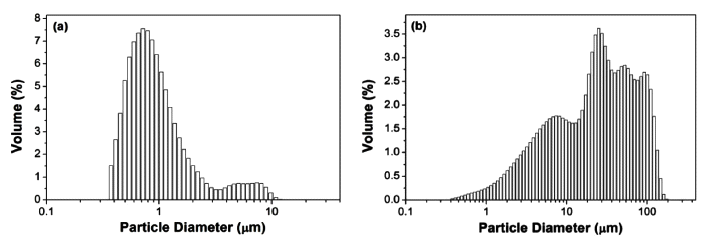
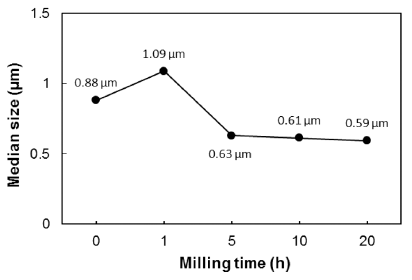
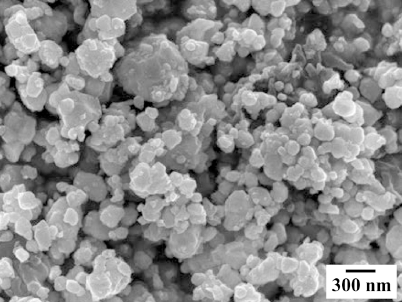

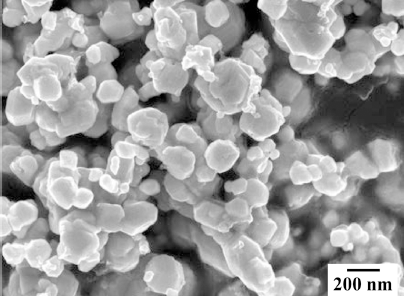

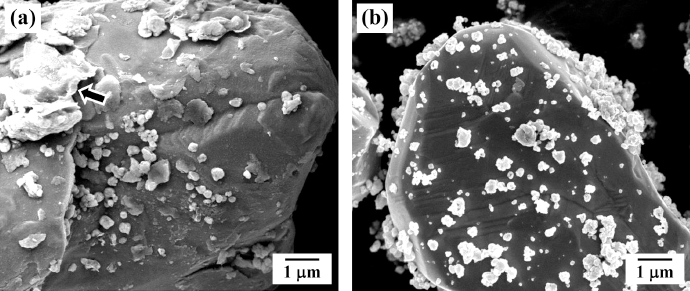
 Cite this Article
Cite this Article









